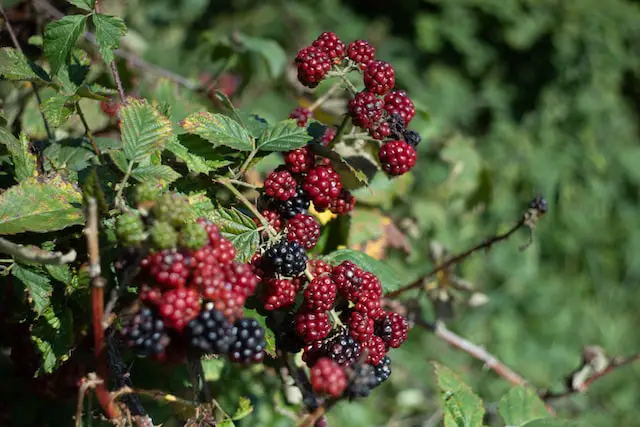
We may receive commissions from purchases made through links in this post, at no additional cost to you.
When I first planted blackberry plants, I chose the perfect spot near my backyard fence on the side of my house…until they grew so vigorously that the canes reached over into the driveway and covered the gate. I had to wrestle the (thankfully, thornless) brambles every time I wanted to enter my backyard.
So it was definitely time for me to move those blackberry shrubs. They had been growing well, giving me tons of big, juicy, sweet berries, but I was tired of having to dodge them all the time. So I had to learn the best way to successfully transplant established blackberry plants.
Transplant mature blackberry bushes in the fall after fruiting, or in early spring while the plant is still dormant. Trim old fruiting canes to the ground, and cut back 1-year-old canes to 4 to 6 inches high to help the plant establish in the new site. Water the new transplant regularly.
There are many reasons you may want to move an established blackberry bush: to divide a large plant into multiple smaller ones, to help a struggling plant thrive in a new site, to provide more sun for better ripening, or (like me) to move a vigorous plant to a less obnoxious location. Let’s explore how to handle transplanting blackberries to give you the best chance of success.
The Best Times to Transplant Blackberries
Blackberry bushes can theoretically be moved at any time of the year, but certain times will be more problematic than others. It’s a good idea to avoid transplanting while the plant is blooming or fruiting so it doesn’t go into shock. Instead, transplant in the fall or early spring for the best chance of survival.
Once the fruit has been harvested in summer, the 2-year-old canes that had fruit on them (floricanes) will die. Cut these canes down to ground level as soon as fruiting is done. Once the cold weather sets in, the remaining 1-year-old canes will go dormant and stop growing, which is the perfect time for transplanting. Then in spring, they will begin growing again, producing blossoms and berries.
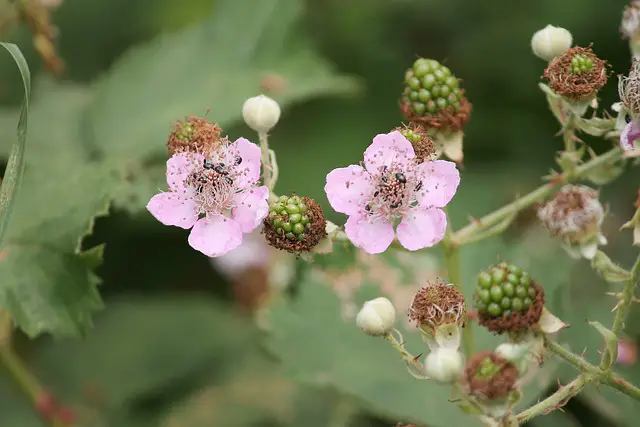
Whether you transplant in fall or spring, you want the plant to focus on establishing its root system in the new location. It shouldn’t be vigorously growing or trying to support tons of blossoms and fruit because then its root system will be weaker, which could damage or kill the plant.
Fall
If you live in a warmer climate, transplant blackberry bushes in the fall after harvesting the fruit. Move an established bush at least 6 weeks before the first frost date so the roots can establish before winter.
By transplanting in the fall, the plant can get accustomed to its new site before going dormant. Then, when spring comes and the plant wakes up, it will be ready to grow and start producing blossoms and berries galore.
I live in zone 8B, and I found that moving my blackberry bushes in the fall meant that they were well established by the time the weather started heating up in late spring. If I’d waited until spring to transplant, the heat of that summer may have been too much for the plant, causing excessive stress.
Early Spring
If you live in a colder climate, the best time to transplant is late winter or early spring while the plant is still dormant. Wait for the time when the ground is warm enough to work, but the canes haven’t shown signs of growth yet.
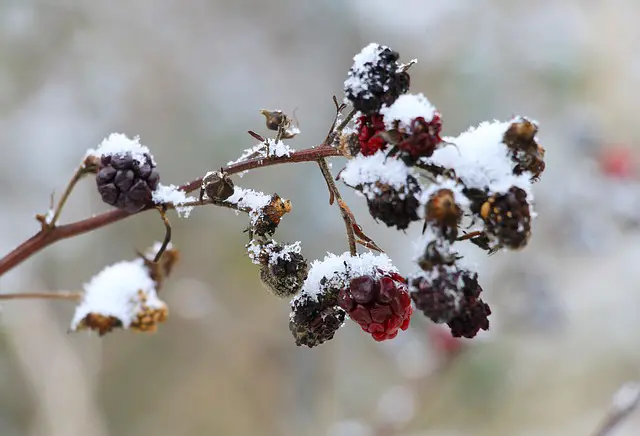
Related: The Best Blackberry Varieties for Cold Climates
Transplanting in early spring will minimize stress on the blackberry bush, since it will be in its new place once it begins to grow. The crop of berries may not be as prolific this year, since a lot of its energy will be put toward root growth, but the plant has a better chance of avoiding shock.
In climates where the frost comes early in the fall, there may not be time to transplant and establish the plant before the cold temperatures come. Better to wait until spring when the chance of cold stress on the new transplant has lessened.
Watch the video below to see how I transplanted my established blackberry bushes:
Preparing the New Planting Site
Before you begin digging up the blackberry plant, go ahead and prep its new location so you will be able to plant it right away. First, select a spot that gets at least 6 hours of sun and leaves plenty of room for the bush to spread. Full sun is essential for ripening the blackberries to peak sweetness.
Learn more: Why are my Blackberries Sour? Tips to Grow Sweeter Berries
Once you have your new site, test the soil (you can use a simple kit like this one). Blackberries need to grow in somewhat acidic soil with a pH ideally between 5.5 and 6.5. The best soil is well-drained, sandy loam with plenty of organic material.
You may need to amend the soil to correct the pH or to help with drainage. It’s a slow process to change the acidity of the soil, but there are ways to do it. To increase soil acidity, apply a sulfur-based acidifying product like this one, according to the package instructions.

You can also dig in material such as peat moss, shredded pine bark, or leaf mold compost, which will increase the acidity as it is broken down over time. Test the soil a few times per season and add additional amendments as necessary to adjust the pH.
If you suspect that your site will hold on to too much water, especially if you have heavy clay soil, then add plenty of organic material to improve drainage. Pine bark, compost, and composted manure will help to aerate the soil and invite worms and other organisms to help.
You can also build up a mound above the soil line to create a raised planting area, allowing water to drain away more quickly. Planting blackberry bushes in a raised bed of any kind gives you more control over the soil and helps avoid drainage issues.
To check a site’s drainage: 1. Dig a 1-foot by 1-foot hole. 2. Fill with water and let drain. 3. Fill with water again and watch to see how fast it drains. If the water soaks in slower than one inch per hour, then it may be too wet. Much faster than one inch per hour, and it may be too dry.
Once you’ve amended the soil, then it’s time to start digging. Make the hole about twice as wide as you estimate the root ball to be (when in doubt, go bigger just to be safe). If you haven’t already, mix in some compost with the native soil. Now you’re ready to start moving the blackberry plant.
Digging Up the Blackberry Transplant
The first thing to do with the blackberry plant is to prune it back. The plant will need all the energy it can spare to establish its roots in the new location, rather than supporting lots of tall canes. Trimming now will greatly reduce the risk of transplant shock.
Related: The Ultimate Guide to Pruning Blackberries (with Photos)
If there are any dead floricanes (the ones that produced berries the previous season), cut them down to soil level. With any remaining canes, prune them to be about 4 to 6 inches high. Once the dormant plant begins growing again, these will grow rapidly and still produce blossoms and berries this year – although it may be a smaller crop, especially if you are transplanting in spring.
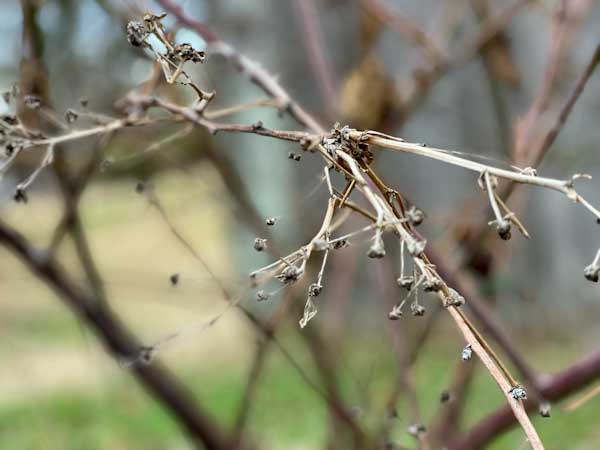
After you’ve pruned, start digging carefully about a foot away from the base of the plant. Try to dig out as much of the root ball as you can. Blackberry roots don’t go too deep, so expect to have to dig about a foot down.
Shake off the excess soil. If the roots seem very dry, soak them in water for up to an hour before re-planting. Trim away any damaged roots or any roots that are excessively long. It may seem harsh to trim some roots, but a little cleanup may actually help the root system be even stronger once it’s transplanted.
Put the plant in the new hole right away if possible, to minimize potential shock. If you can’t re-plant immediately, put the blackberry bush in a nursery pot temporarily until it can be put in the ground, along with any soil that you dug up around the roots.
Re-Planting the Blackberry Bush
Once you place the transplant in its new site, fill in the hole and tamp down the soil carefully to remove air pockets. Water in the newly planted blackberry bush thoroughly. Then top the area around the plant (leaving some space right around the base of the canes) with about 4 inches of mulch, such as pine bark, to insulate the roots and retain moisture in the soil.
If you are transplanting multiple blackberry plants, keep them spaced about 5 or 6 feet apart. Some cultivars stay more compact and can be planted closer, but most blackberries need plenty of room to spread. For trailing varieties, especially if you don’t plan to support them on a trellis, leave 8 or 9 feet of space between.
Avoid fertilizing right away, especially with stronger synthetic fertilizers. Newly transplanted roots are sensitive, even with mature plants. It’s best to wait until the plant’s second year in its new home before adding any fertilizers. If anything, spread some compost that will feed the plant by breaking down slowly over time.
Learn more about feeding blackberry plants in my article, Blackberry Fertilizing: What to Use to Grow the Best Berries.
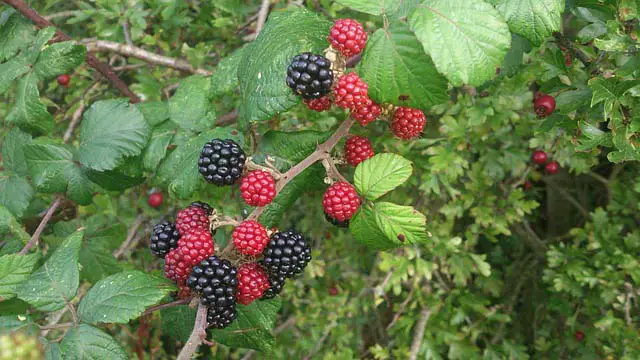
Ongoing Care for Blackberry Transplants
Once the newly transplanted bush starts to grow and bloom, you may choose to support it with a trellis system. There are many ways to do this, ranging from tying the canes to a wall or fence to spread them out, to training the canes and branches to grow along horizontal wires set a few feet above the ground.
Whether or not you use a trellis, all blackberry brambles will benefit from regular pruning at certain times of year. If you want your berries to be bigger, more prolific, and taste as sweet as possible, pruning is an essential part of ongoing blackberry care. Learn more about how and when to prune in The Best Times to Prune Blackberries (for a HUGE Harvest).
Learn more: 6 Ways to Grow Bigger, Juicier Blackberries
Keep the transplant well-watered throughout its first season. Pay special attention to watering regularly during fruiting – underwatering is one of the biggest reasons that blackberries may grow small and tart. Once the plant is established it may need less additional irrigation.

